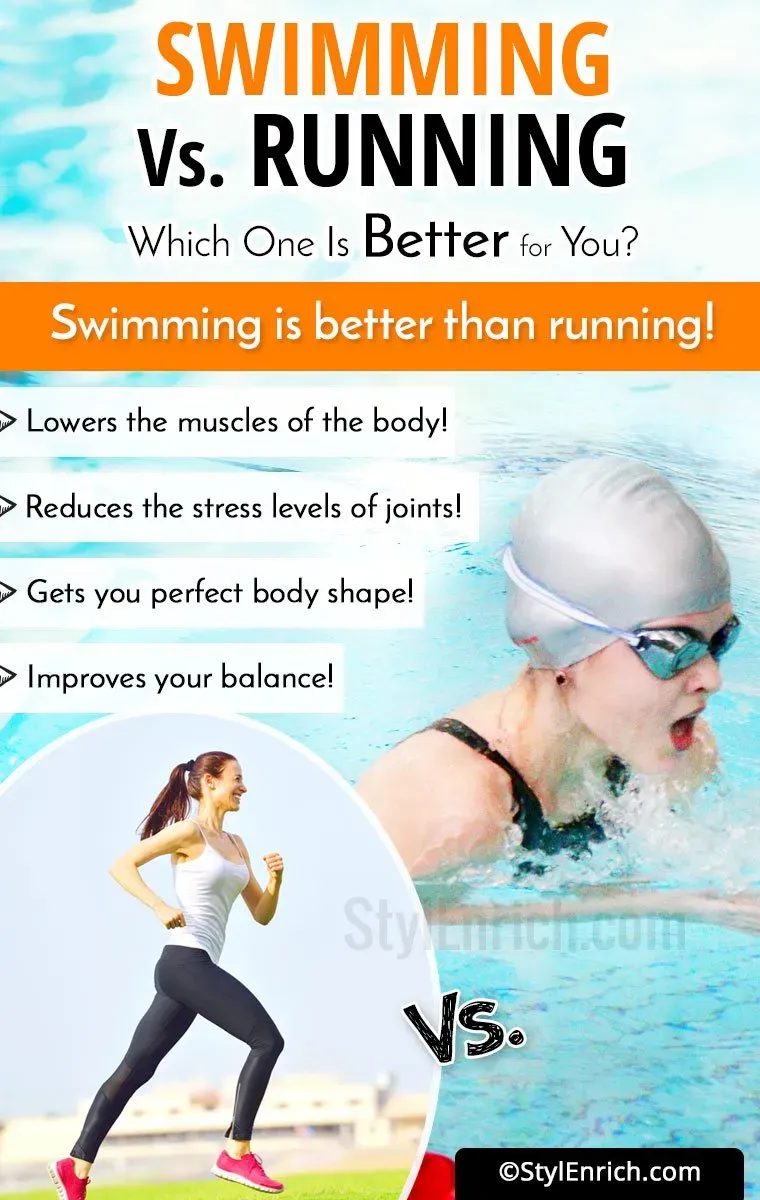When it comes to deciding between swimming vs running, both activities stand out as exceptional forms of cardio workout that cater to different fitness goals. While swimming is known for its smooth, flowing movements in the water, running offers that exhilarating rush of hitting the pavement. An essential aspect of the fitness comparison between these two activities lies in how they impact calories burned swimming versus running; both can be effective, yet they vary in intensity and duration. Diving into the benefits of swimming, one can discover improved joint health and less impact on the body, while running for cardio provides a solid endurance build-up and convenience. Ultimately, discerning which is the best choice for you hinges on personal preferences, fitness goals, and physical conditions.
In the ongoing debate of aquatic exercise versus land-based activities, enthusiasts often weigh swimming against jogging to determine the optimal method for cardiovascular fitness. These two dynamic workouts, both celebrated for enhancing heart health, offer distinct advantages that cater to diverse workout preferences. Swimmers may revel in the buoyant support of water, which alleviates strain on joints, making it easier to sustain higher periods of exertion. Conversely, running presents its own set of challenges by requiring significant gravitational force to propel the body forward, leading to efficient calorie expenditure. Understanding the nuances of these exercises can help fitness fans select the training regimen best suited to their personal health objectives.
Understanding the Benefits of Swimming
Swimming is not only a popular recreational activity; it is an excellent cardiovascular workout that offers numerous health benefits. Engaging in swimming helps elevate heart rate, promotes oxygen circulation, and provides a full-body workout without stressing the joints. Unlike running, which often leads to impact-related injuries, swimming allows individuals to engage in high-intensity exercise in a low-impact environment. This makes swimming an ideal choice for those looking to improve their cardiovascular fitness while minimizing the risk of physical strain.
In addition to cardiovascular health, swimming has been shown to improve flexibility, build muscle strength, and enhance endurance. The resistance of water provides a unique challenge that can efficiently tone muscles, and it is particularly beneficial for individuals recovering from injury or arthritis. As a result, swimming can be considered one of the best forms of cardio exercise for all fitness levels, contributing not just to fitness but also to overall well-being.
The Cardio Benefits of Running for Weight Loss
Running is one of the most popular forms of cardio workouts for weight loss and overall fitness. It can efficiently burn calories, making it an attractive option for those looking to shed pounds. According to research, running at a moderate pace (around 10 minutes per mile) burns approximately 370 calories in just 30 minutes for a 160-pound individual. At a faster pace of 6 minutes per mile, this number rises to about 548 calories. This calorie burn is significant compared to swimming, where similar durations may require greater effort to match the output, especially for newcomers to the sport.
Beyond weight loss, running offers various cardiovascular benefits. It strengthens the heart, improves lung capacity, and increases endurance levels when practiced regularly. The dynamic nature of running can boost mental health, providing stress relief and promoting a sense of well-being through the release of endorphins. Therefore, for those considering a cardio workout, running emerges as a robust choice to achieve fitness goals, particularly in terms of burning calories and fostering heart health.
Swimming vs Running: Which is Better for Cardio?
When comparing swimming vs running, the debate around which is superior for cardiovascular fitness remains ongoing. Both activities engage the heart and lungs effectively, but they do so in distinctly different ways. Swimming, typically deemed a low-impact exercise, allows individuals to perform a full-body workout with improved buoyancy, leading to less strain on the body compared to the impact associated with running. However, running offers greater caloric expenditure during shorter durations, making it a favored option for those focused on quick weight loss results.
Ultimately, the decision may come down to personal preferences and specific fitness goals. Individuals who enjoy outdoor activities and seek an immediate calorie burn may lean toward running, while those preferring a full-body workout that minimizes stress on the joints might favor swimming. Regardless of choice, both sports provide fantastic cardiovascular benefits that can enhance overall physical fitness.
Maximizing Caloric Burn While Swimming
To fully leverage the caloric burn potential while swimming, maintaining proper technique and endurance is key. Novice swimmers may find themselves fatigued quickly, which can hinder their capacity to sustain an effective workout. It is essential to refine swimming skills to enhance swim efficiency, allowing for longer, uninterrupted swims that maintain higher heart rates. Practicing various strokes and focusing on breathing techniques can significantly improve performance and calorie expenditure.
Moreover, swimmers can boost their workout intensity by incorporating intervals or adding swim drills. Engaging in sprint intervals during swim sessions or varying strokes and speeds can optimize calorie burn. According to ACE Fitness, a 160-pound individual can burn up to 378 calories in 30 minutes swimming at a fast recreational pace. This can rival traditional running workouts, provided the swimmer is experienced and capable of sustaining the effort efficiently.
Physical Differences in Swimming and Running
Beyond cardiovascular benefits, swimming and running demand different physical attributes from participants. Runners often develop stronger leg muscles and solid core strength due to the demands of running against gravity. In contrast, swimmers benefit from flexibility in their ankles and shoulders, as the biomechanics of swimming require a different range of motion. The various physical adaptations highlight the unique fitness advantages each sport brings.
This divergence in physical attributes has led to the emergence of hybrid activities like Swim Run, combining both swimming and running in a single workout. Such activities challenge athletes to adapt and utilize the strengths gained from both sports, leveling the playing field and showcasing versatility. Whether choosing to specialize in one or participate in a combination, recognizing and adapting to the physical demands will optimize overall fitness.
Building Muscle Strength in Water
Swimming is often recognized for its cardiovascular benefits, but it also presents an opportunity to build and tone muscle effectively. The resistance provided by water forces swimmers to engage their muscles continuously throughout their movements. However, to maximize muscle-building potential, individuals may need to incorporate specific exercises beyond standard lap swimming. Targeted drills and resistance training within the pool can contribute significantly to muscle development.
For those looking to focus on muscle gain while swimming, integrating movements like aquatic push-ups, leg raises, and resistance band exercises can be effective. These alternative practices not only enhance muscle strength but also contribute to overall fitness by creating a well-rounded workout. Thus, swimming can be more than just an aerobic workout; with the right approach, it can also serve as a comprehensive strength-building exercise.
How Efficient Running Can Boost Your Cardio
Running efficiently can dramatically enhance the cardiovascular benefits you reap from a workout. Proper form and breathing techniques are essential to maximize oxygen intake, which fuels the muscles and supports sustained activity. For beginners, focusing on posture and stride can lead to improved endurance and reduced fatigue, ultimately allowing for longer running durations that elevate cardiovascular conditioning.
Incorporating various running techniques, such as interval training and hill sprints, can also improve cardiovascular fitness more quickly. By combining bursts of high-intensity running with recovery periods, runners can elevate their heart rates extensively, leading to greater calorie burn and improved cardiovascular resilience. Making running a structured and adaptable exercise routine can significantly increase its effectiveness as a cardio workout.
The Role of Heart Health in Cardio Workouts
Both swimming and running play pivotal roles in promoting heart health, encouraging efficient blood circulation and decreasing the risk of cardiovascular diseases. The mechanical benefits of any cardio exercise allow the heart to strengthen and adapt, enhancing its pumping efficiency over time. Whether engaged in the fluid movements of swimming or the rhythmic impacts of running, individuals can expect to see significant improvements in heart function.
Research indicates that regular engagement in either swimming or running results in notable enhancements in cardiac output and heart muscle strength. As the heart adapts to the rhythmic demands of physical activity, both athletes and amateurs alike can enjoy the long-term benefits of reduced heart disease risk. Thus, irrespective of the chosen activity, the focus should remain on consistent engagement to amplify heart health through quality cardio exercise.
Choosing the Right Cardio for Your Lifestyle
Ultimately, the decision to choose swimming or running for cardiovascular exercise boils down to personal preferences and lifestyle factors. For those who enjoy the water and find it refreshing to swim laps, swimming may be the more appealing option. With various swimming styles and techniques available, it can be a versatile workout that prevents boredom and promotes adherence to fitness routines.
On the other hand, running offers accessibility, requiring little more than a good pair of shoes. With running clubs and community events, it can offer social engagement that may motivate individuals to stay consistent. Ultimately, the best cardio workout is the one that individuals will stick to long-term, as consistency is key to reaping the full benefits of any cardiovascular exercise.
Frequently Asked Questions
Which cardio workout is better, swimming vs running?
The question of which cardio workout is better between swimming and running largely depends on individual fitness goals and preferences. Both swimming and running provide excellent cardiovascular benefits, but they target different muscle groups and require different physical adaptations. Swimming is a low-impact exercise that is easier on the joints, making it ideal for individuals seeking a gentler alternative. Running, on the other hand, typically burns more calories in a shorter time due to the gravitational resistance, appealing to those focused on high-intensity workouts. Ultimately, the best choice for you will depend on your personal fitness objectives, body type, and any existing injuries.
How many calories are burned swimming compared to running?
The calories burned during swimming vs running vary based on intensity and duration. For a 160-pound individual, swimming at a fast recreational pace burns approximately 378 calories in 30 minutes, while running at a 10-minute mile pace burns about 370 calories. Running at a faster pace, such as a 6-minute mile, can burn significantly more calories, around 548 calories in the same timeframe. Both activities can effectively contribute to weight loss and cardiovascular fitness, but you may need to swim longer to match the caloric output of a high-speed run.
What are the benefits of swimming as a cardio workout?
Swimming offers numerous benefits as a cardio workout, including improved cardiovascular endurance, increased lung capacity, and enhanced muscle toning. Unlike running, swimming is low-impact, reducing stress on joints while still providing a full-body workout. It’s also an excellent option for cross-training, aiding recovery from other high-impact exercises. Moreover, swimming can enhance flexibility due to the range of motion involved in strokes, making it a holistic fitness choice that improves overall conditioning.
Is running better for cardio than swimming for building muscle?
While both running and swimming can improve overall fitness, running is often more effective for building muscle due to the specific muscle engagement involved in the activity. Running builds lower body muscles effectively, while swimming primarily tones muscles throughout the entire body but isn’t as focused on muscle building. However, those seeking muscle gains can combine swimming with resistance training or specific swimming drills to enhance muscle strength, making both cardio workouts beneficial in their own right.
Can swimming effectively improve cardiovascular fitness compared to running?
Yes, swimming can significantly improve cardiovascular fitness, much like running does. Both activities elevate heart rate and enhance aerobic capacity. While research indicates that runners may have larger left ventricles due to the impact of gravity, swimmers also achieve substantial heart health benefits. Efficient swimming techniques can provide a robust cardio workout, making it just as effective for building cardiovascular endurance as running.
What should I choose for my cardio workout, swimming or running?
Choosing between swimming and running for your cardio workout should be based on your fitness goals, physical condition, and personal preferences. If you enjoy low-impact exercise or are recovering from an injury, swimming may be the better choice. Conversely, if you aim for higher caloric burn in a shorter time and don’t have joint issues, running might be more suitable. Ultimately, incorporating both into your routine could provide a balanced approach to cardio fitness.
| Aspect | Swimming | Running |
|---|---|---|
| Cardio Effectiveness | Effective cardiovascular workout that increases heart rate and oxygen consumption. | Also an excellent cardiovascular activity that builds aerobic capacity and strengthens the heart. |
| Heart Adaptation | Leads to heart adaptation with less strain due to water buoyancy. | Strain due to gravity leads to larger heart adaptations over time. |
| Caloric Burn (30 mins) | 378 calories (fast pace) / 312 calories (moderate pace). | 370 calories (10-min mile pace) / 548 calories (6-min mile pace). |
| Physical Attributes | Requires flexibility, with a focus on smooth, efficient movements. | Requires stiffness in ankles and strong leg muscles for propulsion. |
| Muscle Building | Can tone the body, but requires specialized exercises for muscle building. | Effective for building muscle in the legs and core through resistance. |
| Integrated Activities | Part of a growing trend in Swim Run events that combine both disciplines. | Swim Run events challenge both swimmers and runners equally. |
Summary
Swimming vs running has long been a topic of debate among fitness enthusiasts. Both activities offer excellent cardiovascular benefits and help improve overall health, though they do so in different ways. Swimming is gentler on the joints and may provide a better muscle-toning workout, while running tends to burn more calories in a shorter period. Ultimately, the best workout depends on personal preference, fitness goals, and individual physical attributes.



